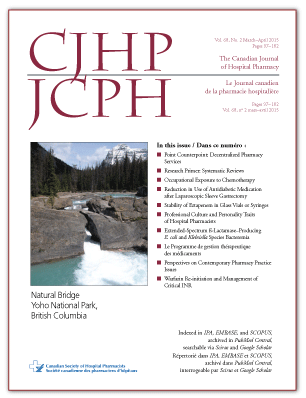Occupational Exposure to Chemotherapy of Pharmacy Personnel at a Single Centre
DOI:
https://doi.org/10.4212/cjhp.v68i2.1435Keywords:
occupational exposure, chemotherapy, pharmacy, biological exposure, environmental exposure, exposition professionnelle, chimiothérapie, pharmacie, exposition biologique, exposition environnementaleAbstract
ABSTRACT
Background: Cyclophosphamide is one of the most commonly used chemotherapy drugs worldwide. Data concerning environmental contamination and biological exposure of pharmacy personnel to this and other chemotherapy drugs are limited.
Objectives: To determine whether pharmacy personnel involved in preparing and checking cyclophosphamide doses were more likely to have detectable levels of this drug in their urine than non-oncology pharmacy personnel with no known contact with the drug, and to compare the degree of surface contamination with cyclophosphamide, methotrexate, and ifosfamide in the oncology pharmacy of a tertiary care pediatric hospital, where chemotherapy doses were prepared, and the main (control) pharmacy in the same institution, where no chemotherapy was prepared.
Methods: Biological exposure to cyclophosphamide was compared between pharmacy personnel who did and did not handle this drug by determining whether participants had detectable amounts of cyclophosphamide in their urine. Environmental exposure to chemotherapy drugs was assessed by using surface wipes to determine the degree of surface contamination with various chemotherapy agents in the oncology pharmacy and the main (control) pharmacy.
Results: On initial testing, cyclophosphamide was detected in the urine of all pharmacy personnel (n = 7 oncology personnel, n = 5 control personnel). However, it was determined that all control personnel had been exposed to the oncology pharmacy on the day of testing. Repeat testing of these individuals revealed no positive samples among those not exposed to the oncology pharmacy on the day of repeat testing. The sole positive result on retesting of control personnel was for a participant who had been exposed to the oncology pharmacy on the retest day. Surface wipe testing revealed contamination of the oncology pharmacy with cyclophosphamide and methotrexate before and after cleaning, as well as contamination with ifosfamide after cleaning. The main (control) pharmacy showed no evidence of contamination with cyclophosphamide, methotrexate, or ifosfamide.
Conclusions: The findings suggest that environmental contamination plays a role in biological exposure to cyclophosphamide. Measures to reduce environmental contamination from chemotherapy and biological exposure of pharmacy personnel when handling chemotherapy agents should be identified and implemented as a priority.
RÉSUMÉ
Contexte : La cyclophosphamide est l’un des médicaments de chimiothérapie les plus couramment utilisés dans le monde. Or, il n’y a que très peu de données sur la contamination environnementale et l’exposition biologique du personnel de pharmacie à ces produits.
Objectifs : Déterminer si le personnel de pharmacie s’occupant de la préparation et de la vérification des doses de cyclophosphamide est plus susceptible de présenter des concentrations détectables de ce médicament dans leurs urines que le personnel de pharmacie ne travaillant pas en oncologie, donc sans contact connu avec ce médicament, et comparer le niveau de contamination de surface par la cyclophosphamide, le méthotrexate et l’ifosfamide dans la pharmacie d’oncologie d’un hôpital pédiatrique de soins tertiaires, où sont préparées les doses de chimiothérapie, à celui dans la pharmacie principale (témoin) du même établissement, où n’est préparée aucune chimiothérapie.
Méthodes : L’on a comparé l’exposition biologique à la cyclophosphamide du personnel de pharmacie ayant manipulé ce médicament à celle de personnel ne l’ayant pas manipulé en examinant si les participants présentaient des concentrations détectables de cyclophosphamide dans leurs urines. L’exposition environnementale aux produits de chimiothérapie a été évaluée à l’aide de lingettes utilisées pour essuyer les surfaces de la pharmacie d’oncologie et de la pharmacie principale (témoin) afin d’en déterminer les niveaux de contamination par différents agents de chimiothérapie.
Résultats : Lors de l’analyse initiale, des concentrations de cyclophosphamide ont été détectées dans les urines de l’ensemble du personnel de pharmacie (n = 7 dans l’équipe en oncologie et n = 5 dans le groupe témoin). Mais l’on a constaté que tout le personnel du groupe témoin avait été exposé à la pharmacie d’oncologie le jour de l’analyse. Une seconde analyse chez ces personnes s’est montrée négative pour celles n’ayant pas été exposées à la pharmacie d’oncologie le jour de cette seconde analyse. Le seul résultat positif observé au cours de la seconde analyse chez le personnel du groupe témoin concernait un participant ayant été exposé à la pharmacie d’oncologie le jour de la seconde analyse. L’analyse des lingettes a révélé une contamination des surfaces de la pharmacie d’oncologie par la cyclophosphamide et le méthotrexate avant et après nettoyage ainsi qu’une contamination par l’ifosfamide après nettoyage. La pharmacie principale (témoin) ne présentait quant à elle aucun signe de contamination par l’un ou l’autre des trois produits.
Conclusions : D’après ces résultats, la contamination environnementale joue un rôle dans l’exposition biologique à la cyclophosphamide. Ainsi, trouver et mettre en place des mesures visant à réduire la contamination environnementale par les produits de chimiothérapie et l’exposition biologique du personnel de pharmacie lors de la manipulation de ces produits doit représenter une priorité.
Downloads
Published
Issue
Section
License
Copyright © Canadian Society of Healthcare-Systems Pharmacy.
After publication of a manuscript in the CJHP, the authors of the manuscript must obtain written permission from the CSHP (publications@cshp.ca) before reproducing any text, figures, tables, or illustrations from the work in future works of their own. If a submitted manuscript is declined for publication in the CJHP, all said rights shall revert to the authors. Please note that any forms (e.g., preprinted orders and patient intake forms) used by a specific hospital or other health care facility and included as illustrative material with a manuscript are exempt from this copyright transfer. The CJHP will require a letter from the hospital or health care facility granting permission to publish the document(s).










